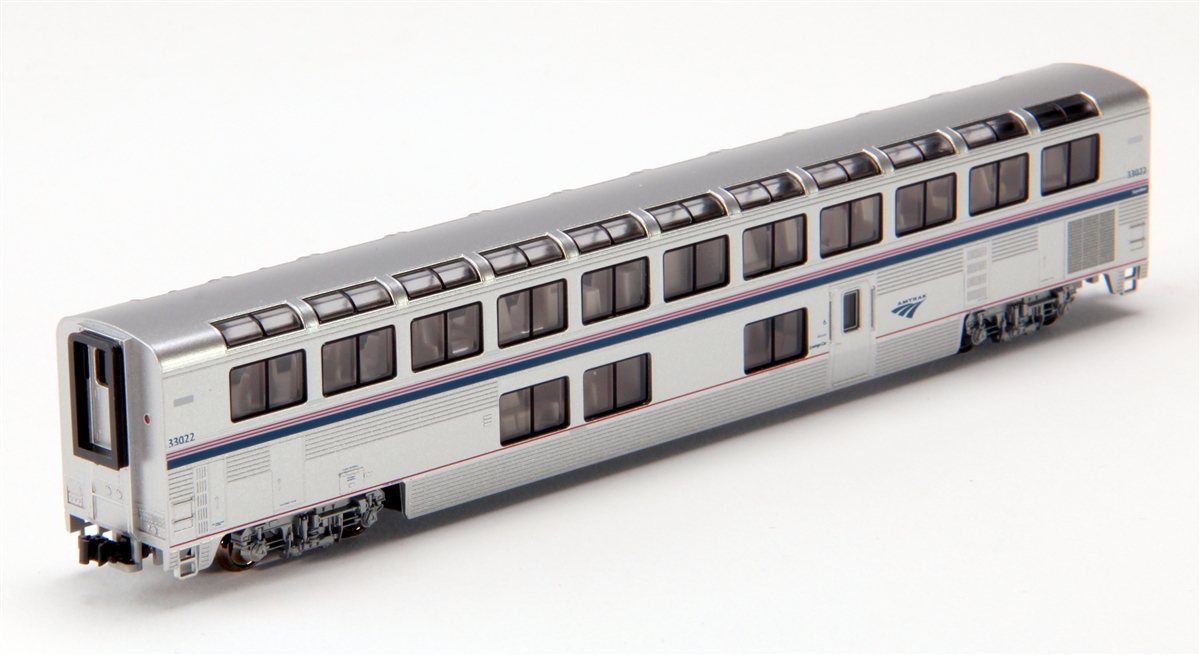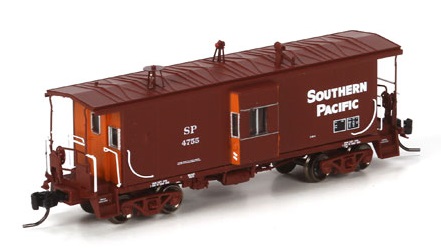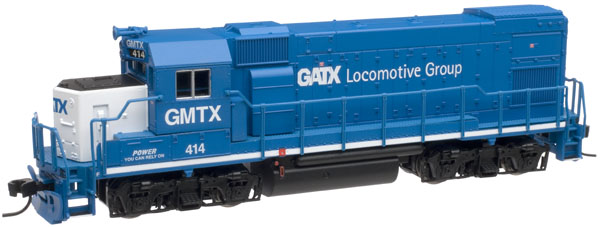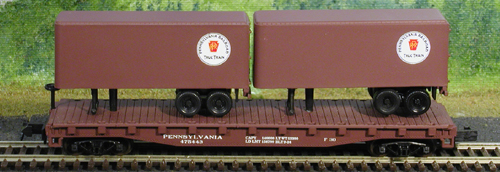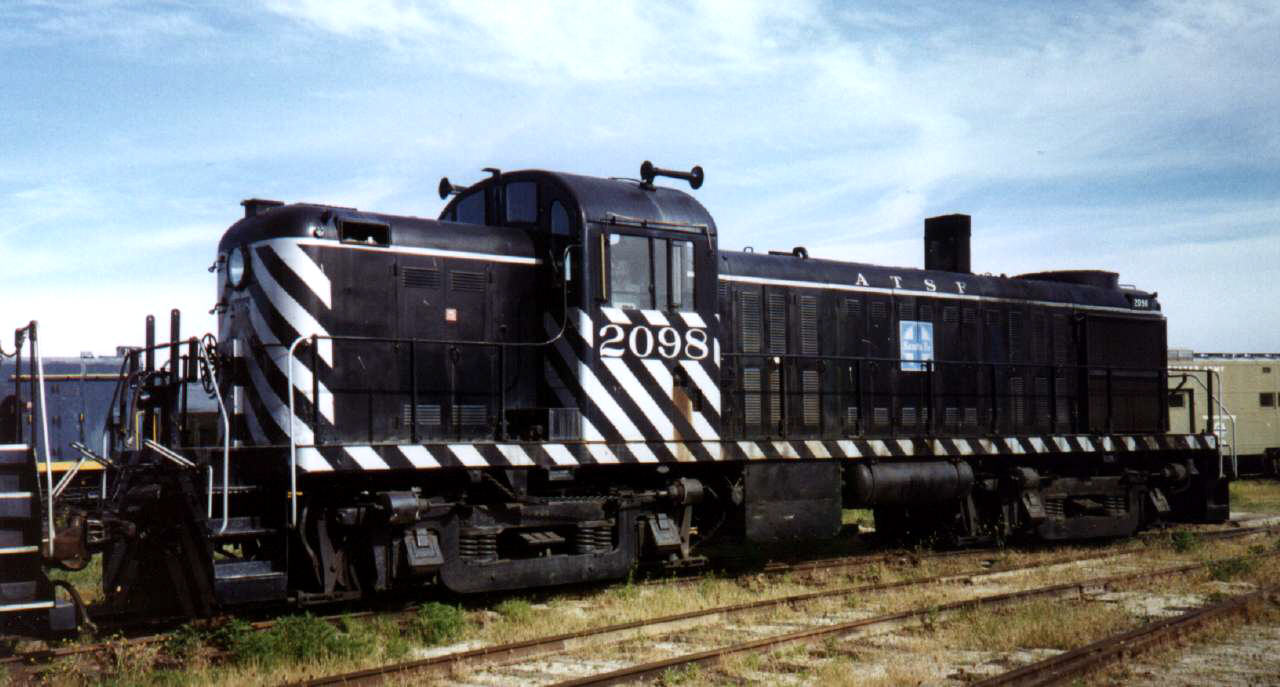Model Information: First released in 2007. Subsequent releases in 2008, 2011 and in 2012 (with MTL couplers). A fifth release was announced in 2012, but eventually cancelled due to insufficient reservations.
Re-run under Atlas brand in 2019 after Atlas purchased the tooling from Walthers.
Features:
Re-run under Atlas brand in 2019 after Atlas purchased the tooling from Walthers.
Features:
- split-frame, all-metal, DCC-Friendly chassis,
- 5-pole skew-wound "scale speed" motor, with dual flywheels,
- low-friction drive,
- bi-directional LED lighting,
- all-wheel drive and pickup (no traction tires),
- blackened, low-profile wheels,
- body-mounted Accumate couplers.
DCC Information: Contrary to the above review, due to the amount of effort required to install a decoder, we elected to classify this as DCC-Friendly.
Accepts the following plug-in decoders (non-sound), but requires a full disassembly of the locomotives, and proper isolation of the motor from the chassis with insulating tape:
- Digitrax DN163K2: 1 Amp N Scale Mobile Decoder for Kato N scale SD80/90MAC Series, RSC2, RS2. See installation tips on Digitrax website.
- TCS K2D4: N-scale drop-in decoder designed for Kato RS2/RSC2, SD80/SD90MAC and Life-Like/Walthers RS2, GP18 locomotives. See installation tips on TCS website.
The Atlas version of 2019 comes either with a factory-installed DCC decoder or in DC version.
Accepts the following plug-in decoders (non-sound), but requires a full disassembly of the locomotives, and proper isolation of the motor from the chassis with insulating tape:
- Digitrax DN163K2: 1 Amp N Scale Mobile Decoder for Kato N scale SD80/90MAC Series, RSC2, RS2. See installation tips on Digitrax website.
- TCS K2D4: N-scale drop-in decoder designed for Kato RS2/RSC2, SD80/SD90MAC and Life-Like/Walthers RS2, GP18 locomotives. See installation tips on TCS website.
The Atlas version of 2019 comes either with a factory-installed DCC decoder or in DC version.
Prototype History: The ALCO RS-2 is a 1,500–1,600 horsepower (1,100–1,200 kW) B-B road switcher diesel-electric locomotive built by the American Locomotive Company (ALCO) from 1946 to 1950. ALCO introduced the model after World War II as an improvement on the ALCO RS-1. The locomotive was one of several road switchers in a crowded market, including the Baldwin DRS-4-4-1500, EMD GP7, and FM H-15-44. ALCO discontinued the RS-2 in 1950 in favor of the ALCO RS-3. Several examples have been preserved.
383 locomotives were produced — 374 by the American Locomotive Company, and 9 by Montreal Locomotive Works in Canada. Eight of the ALCO RS-2s were exported to Canada. The RS-2 has a single, 12 cylinder, model 244B engine, developing 1,500 horsepower (1,100 kW). Thirty-one locomotives built by Alco between February and May 1950 with the 12 cylinder 244C 1,600 horsepower (1,200 kW) engine.
From Wikipedia
Read more on American-Rails.com
383 locomotives were produced — 374 by the American Locomotive Company, and 9 by Montreal Locomotive Works in Canada. Eight of the ALCO RS-2s were exported to Canada. The RS-2 has a single, 12 cylinder, model 244B engine, developing 1,500 horsepower (1,100 kW). Thirty-one locomotives built by Alco between February and May 1950 with the 12 cylinder 244C 1,600 horsepower (1,200 kW) engine.
From Wikipedia
Read more on American-Rails.com
Road Name History: The Union Pacific Railroad (reporting mark UP) is a freight hauling railroad that operates 8,500 locomotives over 32,100 route-miles in 23 states west of Chicago, Illinois and New Orleans, Louisiana. The Union Pacific Railroad network is the largest in the United States and employs 42,600 people. It is also one of the world's largest transportation companies.
Union Pacific Railroad is the principal operating company of Union Pacific Corporation (NYSE: UNP); both are headquartered in Omaha, Nebraska. Over the years Union Pacific Corporation has grown by acquiring other railroads, notably the Missouri Pacific, Chicago & North Western, Western Pacific, Missouri-Kansas-Texas, and the Southern Pacific (including the Denver & Rio Grande Western).
Union Pacific Corporation's main competitor is the BNSF Railway, the nation's second largest freight railroad, which also primarily services the Continental U.S. west of the Mississippi River. Together, the two railroads have a duopoly on all transcontinental freight rail lines in the U.S.
Read more on Wikipedia and on Union Pacific official website.
Union Pacific Railroad is the principal operating company of Union Pacific Corporation (NYSE: UNP); both are headquartered in Omaha, Nebraska. Over the years Union Pacific Corporation has grown by acquiring other railroads, notably the Missouri Pacific, Chicago & North Western, Western Pacific, Missouri-Kansas-Texas, and the Southern Pacific (including the Denver & Rio Grande Western).
Union Pacific Corporation's main competitor is the BNSF Railway, the nation's second largest freight railroad, which also primarily services the Continental U.S. west of the Mississippi River. Together, the two railroads have a duopoly on all transcontinental freight rail lines in the U.S.
Read more on Wikipedia and on Union Pacific official website.
Brand/Importer Information: Wm. K. Walthers, Inc., was founded in Milwaukee in 1932 -- but really, it started years earlier, when seven-year-old Bill Walthers got his first taste of the hobby with a small, wind-up toy train for Christmas. He continued with the hobby and eventually had an attic layout comprised primarily of his own scratch-built creations. After he wrote a series of articles on building train control and signaling systems, he got so many letters from other modelers that he began manufacturing them. The first ad (in the May issue of The Model Maker) offered a 24-page, 15c catalog that listed rail, couplers, and electrical supplies. Sales were over $500.00 for the first year, and the fledgling company was off to a strong start.
Within five years, Walthers had grown so much that larger quarters were needed. Space was found on Erie Street, where everything -- from milled wood parts to metal castings to decals -- was made in-house. 1937 also saw a new line in HO Scale, featured in its own catalog. Bill brought operating layouts to the 1939 World's Fair, which gave the hobby a big boost. Soon, though, the growing possibility of war overshadowed these successes, and supplies were becoming increasingly difficult to obtain.
During the war, model manufacturers were ordered to stop production in order to conserve critical metal supplies. Walthers produced what it could from nonessential materials. A series of ads in 1943 saw Bill literally scraping the bottom of a barrel! The postwar boom meant rapid growth for the hobby; however, small homes and new families left no room for O scale layouts, and many modelers moved to HO Scale.
The next twenty years brought great change. In 1958, Bill retired and his son Bruce took over. Just as full-size railroads were being hard-hit by new technology, so too were model railroads. Leisure time was spent in front of the TV set, not the train set. In 1960, Walthers became a full-line distributor of other manufacturers' products while continuing expansion of the Walthers lines. By the start of the 1970's, business was booming again, and Bruce's son Phil joined the company.
Expansion and diversification continue under Phil's tenure. The establishment of the Walthers Importing Division added several international lines. The manufacturing plant was modernized. Code 83 track was introduced in 1985, giving layouts more realistic proportions. In 1990, the Cornerstone Series buildings were unveiled. Combining a freight car with a related industry, the Cornerstone Series makes it possible for modelers to duplicate authentic operations, enhancing layout realism. The Train Line Deluxe Sets and locomotives debuted in 1994. These sets feature the detailing of serious models and an affordable price -- allowing newcomers to get started, and then build-on to their first set, rather than replacing it.
In 2005, Walthers purchased Life-Like from Lifoam Industries. With this purchase Walthers acquired the Proto Lines that have become the backbone of their locomotive and rolling stock segments.
Today, Walthers continues to expand, improve and develop a wide range of products. Their latest selection can be found throughout Walthers.com and their printed catalogs, along with items from over 300 other manufacturers.
In December 2017, Lowell Smith announced the ‘purchase of tooling’ of the Walthers line of N Scale passenger cars (sleeper, coach and baggage cars), and in June 2018, Atlas announced that it will purchase all N scale locomotive and rolling stock tooling owned by Walthers, including the Walthers N tooling as well as former Life-Like tooling. This divestment puts an end to Walthers involvement as a manufacturer of N scale rolling-stock, though it will continue its range of N scale structures.
Within five years, Walthers had grown so much that larger quarters were needed. Space was found on Erie Street, where everything -- from milled wood parts to metal castings to decals -- was made in-house. 1937 also saw a new line in HO Scale, featured in its own catalog. Bill brought operating layouts to the 1939 World's Fair, which gave the hobby a big boost. Soon, though, the growing possibility of war overshadowed these successes, and supplies were becoming increasingly difficult to obtain.
During the war, model manufacturers were ordered to stop production in order to conserve critical metal supplies. Walthers produced what it could from nonessential materials. A series of ads in 1943 saw Bill literally scraping the bottom of a barrel! The postwar boom meant rapid growth for the hobby; however, small homes and new families left no room for O scale layouts, and many modelers moved to HO Scale.
The next twenty years brought great change. In 1958, Bill retired and his son Bruce took over. Just as full-size railroads were being hard-hit by new technology, so too were model railroads. Leisure time was spent in front of the TV set, not the train set. In 1960, Walthers became a full-line distributor of other manufacturers' products while continuing expansion of the Walthers lines. By the start of the 1970's, business was booming again, and Bruce's son Phil joined the company.
Expansion and diversification continue under Phil's tenure. The establishment of the Walthers Importing Division added several international lines. The manufacturing plant was modernized. Code 83 track was introduced in 1985, giving layouts more realistic proportions. In 1990, the Cornerstone Series buildings were unveiled. Combining a freight car with a related industry, the Cornerstone Series makes it possible for modelers to duplicate authentic operations, enhancing layout realism. The Train Line Deluxe Sets and locomotives debuted in 1994. These sets feature the detailing of serious models and an affordable price -- allowing newcomers to get started, and then build-on to their first set, rather than replacing it.
In 2005, Walthers purchased Life-Like from Lifoam Industries. With this purchase Walthers acquired the Proto Lines that have become the backbone of their locomotive and rolling stock segments.
Today, Walthers continues to expand, improve and develop a wide range of products. Their latest selection can be found throughout Walthers.com and their printed catalogs, along with items from over 300 other manufacturers.
In December 2017, Lowell Smith announced the ‘purchase of tooling’ of the Walthers line of N Scale passenger cars (sleeper, coach and baggage cars), and in June 2018, Atlas announced that it will purchase all N scale locomotive and rolling stock tooling owned by Walthers, including the Walthers N tooling as well as former Life-Like tooling. This divestment puts an end to Walthers involvement as a manufacturer of N scale rolling-stock, though it will continue its range of N scale structures.
Item created by: Alain LM on 2018-08-10 15:37:58
If you see errors or missing data in this entry, please feel free to log in and edit it. Anyone with a Gmail account can log in instantly.
If you see errors or missing data in this entry, please feel free to log in and edit it. Anyone with a Gmail account can log in instantly.






